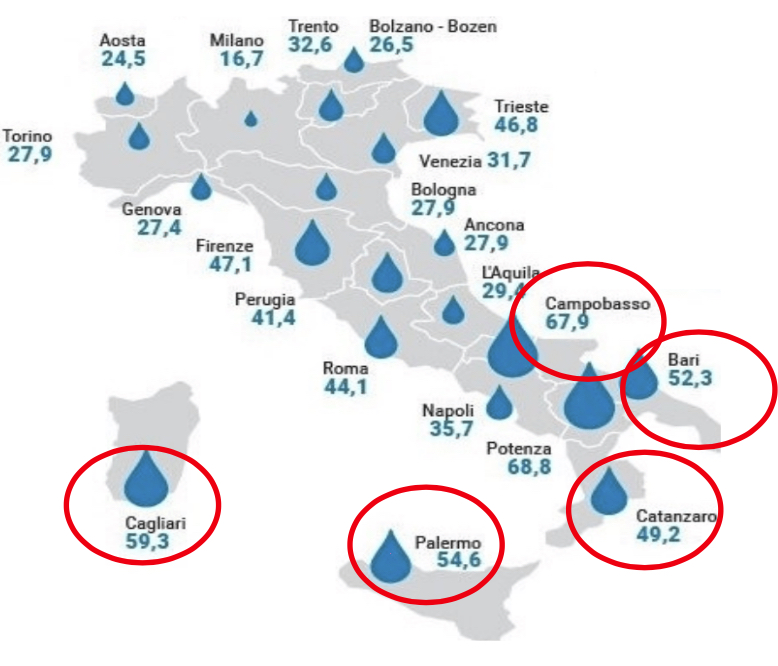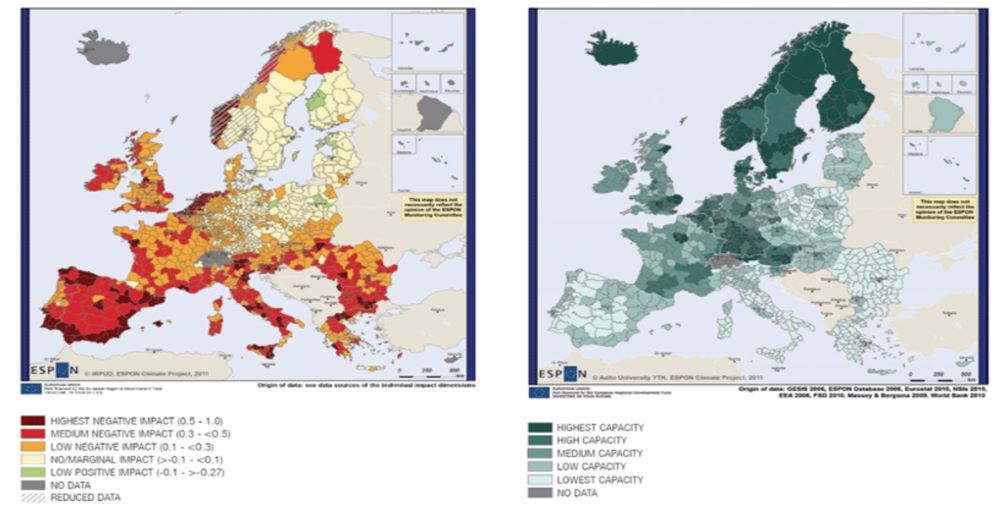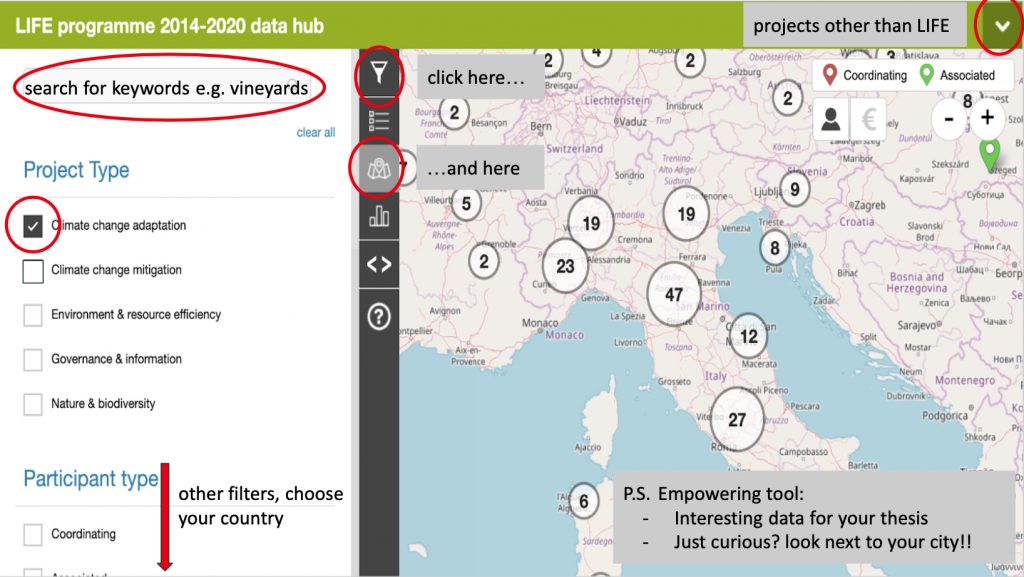
Sustainable Finance: A Brief Presentation
28 November 2022
French Climate Action
5 December 2022By Titouan Coupry, Luca De Carolis, Christiana Kyriazi, Alexis Reymondon
Why you should read
The CLINOMICS project is a LIFE-winning project mainly about climate change adaptation. Why is this project interesting? Because it concerns you. Think about this summer: droughts everywhere in Europe. France experiencing record-high temperatures, rivers drying up (WMO, 2022; ESA, 2022). Think about previous summers: floods in Germany and all over Europe (WMO, 2021).
As can be seen, climate change creates many problems and, to make the situation worse, some governments do not act. In Israel, every single drop of water is saved by a drop irrigation system, while between 2015-2018 in Italy 47,9% of the drinkable water was lost along the way (Megersa and Abdulahi, 2015; ISTAT, 2019). If one thinks that the Po River in Northern Italy was almost dried up during this summer, these statistics should spur some backlash (ESA, 2022).

Moreover, governments’ weak action is not just an Italian problem: as it can be seen from the two maps below, Southern European regions are potentially the most impacted by climate risks, but also the least able to adapt to climate change (ESPON, 2012). LIFE was born to help these regions out and – to optimize “scarce” funds – it selects projects that can be co-financed by privates and that can create best practices.

The 5Ws + How of CLINOMICS
In 2016, one of the problematic regions (according to the maps above) was Catalonia. Aware of the issue, the local government submits the CLINOMICS project to LIFE and gets selected and co-financed with 1.3 million euros (Layman Report, 2020).
CLINOMICS, as the name says, was conceived to create a CLImate–adapted-EcoNOMICS. The story unfolds between 2016 and 2020 in three territories and four sectors of the local economy, and – summarised in one sentence – it consisted in passing from knowledge to new governance (Layman Report, 2020).
Indeed, the project started with territorial studies for the identification of risks, passed through the set-up of forums where stakeholders could discuss and select actions to adapt, and ended with a coordinated implementation of six pilot actions that you can see in the table below (Layman Report, 2020).

The rest of this blogpost will be organized as follows: to better understand the general methodology described in the previous paragraph, we focus on the Drought Observatory pilot, then we provide an evaluation of the project and some considerations on its generalizability. Lastly, we conclude with some critical thoughts and an invitation to use the LIFE data Hub tool.
CLINOMICS CONCRETELY: The Drought Observatory Problem
To grasp key elements of the Drought Observatory Project, we have worked on a newsletter published by Life Clinomics in May 2019 that gives key information, on a scientific article on soil management (Lazcano, 2020) as well as on press articles to understand how these Clinomics initiatives were received (Catalan News, 2019).
Geographically, the Terres de l’Ebre Biosphere Reserve and the Alt Penedes County are both characterized by inlands, plains, fluvial spaces, and landscapes of vineyards. Indeed, Alt Penedes County benefits from a strong wine production that constitutes the basis of the country’s wine industry. To such an extent that a part of tourism in these territories resides in wine products.
As a consequence, the question of climate adaptation represents the key issue both in agriculture and tourism. The main challenge is to reduce the impacts of droughts in vineyards through the implementation of more efficient irrigation techniques.
Concretely, to give a precise example, two techniques have been implemented in both of these territories:
Firstly, thanks to the installation of sensors planted close to the roots in the subsoil to detect humidity, the existing reserves of water can be precisely controlled. With this system, the monitoring of hydric stress in vineyards is improved.
Secondly, this system is coordinated with the input of meteorological data that provides a greater technical assessment for wine producers in terms of soil management.

According to local testimonies, these innovations were well-received by wine producers that can really get used to climate change in their activities. Thus, the European Life Clinomics project succeeded in coordinating the Barcelona regional council, the county council and local actors to make their decisions sustainably.
SWOT Analysis
In reference to the SWOT Analysis of the LIFE Clinomics project, the strengths are concentrating on the rich partnership that facilitates addressing different aspects of the climate change adaptation, but also on all the actions that contribute to the increase of awareness on environmental and climate change issues. (Afterlife Plan, 2020)
The main weaknesses are the lack of funds and the difficulty to engage local stakeholders, because of their unawareness or their lack of interest in climate change adaptation actions.
However, LIFE Clinomics showed significant opportunities, such as better knowledge of climate change impacts, the engagement of more than 100 actions for the increase of resilience in the climate change, the reinforcement of the insurance sector in order to support the local businesses from the climate change impacts and the total development of the governance structures for the local stakeholders to become more engaged.
Finally, regarding the threats, the LIFE Clinomics project should be more cautious of the financial problem of accessing funds, even though there has been an increase in the link between funding and local adaptation to climate change.
Summarising, the lessons learned from the LIFE Clinomics are the following:
- Governance is necessary to identify the main actors and take advantage of participation structures.
- Both technical and experiential knowledge is essential to tackle the lack of awareness of the local climate change impacts.
- Specific actions and the involvement of different actors are needed.
- Training on adaptation to climate change and a joint strategy for action and governance are significant.
Relevance to the European Climate Action
The LIFE Clinomics also accomplished some important goals of the European Climate Actions.
Firstly, it increased knowledge and action on climate change adaptation among public and private stakeholders, thus contributing to the goal set by the European Green Deal of supporting stakeholders “to access data and to develop instruments to integrate climate change into their risk management practices”.
Secondly, it showed the negative impacts of climate change in the territories of the project but at the same time, the opportunities that can be achieved by integrating the vision of the EU strategy on adaptation considering that adaptation can generate economic benefits.
Thirdly, CLINOMICS has contributed to mainstream adaptation in the different organizations of its partnership, as well as in the three territories of the project and beyond. Finally, contributed to the public consultation on the new EU strategy on adaptation to climate change by boosting adaptive capacity, strengthening resilience and reducing vulnerability to climate change as stated in the EU strategy.
Transposable or not? Clinomics between his strengths and weaknesses
Finally, the interest of this type of project lies in its capacity to be transposed to other scales.
First, at the regional level, the lessons learned from Clinomics have become an essential basis for the Catalan Climate Action Plan 2021/2030 (which goes further than Clinomics), in that it takes up certain methodological elements (calculation of vulnerability, involvement of all stakeholders for the more important elements). It should be noted that at this level, Clinomics constitutes a stage within a given trajectory of reforms, begun at the beginning of 2010 with MeTaccs and continued afterwards. In this respect, the project is part of the path dependency concept.
Then, the regional level is complemented by the Mediterranean level. The knowledge (data, methodology) acquired is shared during various trans-Mediterranean conferences such as Agriadapt and Lifeproject. More generally, the transfer of knowledge and methodology is based on a network action. Therefore, Clinomics has signed the “pact for adaptation to climate”, which links different companies and administrations in Spain and around the Mediterranean.
However, this same pact is an example of the limits of transfer: it was mainly signed by Spanish entities. It remains confined to a specific geographical area. This is partly due to the difficult access to the precise lessons learned from the project, as well as its poor publicity at the European level (although it was a finalist in the Life projects). Also, in the question of transfer, transposition to other regions does not take into account the institutional factor among countries, in the sense of the question of competencies.
Although this limits the real effectiveness of Clinomics, the project has put in place an afterlife plan. Among other things, it plans to strengthen the actions already carried out in the three different project territories and to replicate them in 26 new Catalan locations, to promote local practices that will help combat global warming more effectively. Finally, the project, despite its end, plans to continue its publicity in order to spread the practices, with a toolbox on adaptation to climate change for economic entities, learned from the experience as widely as possible.
Discussion and invitation
Before concluding, we would like to stimulate critical thinking and curiosity by asking some provocative questions.
Firstly, the budget. Out of 1.3 million Euros, just €150,000 (slightly more than 10%) were spent on the Pilot actions (Afterlife Plan, 2020). Please ask yourself: where did the remaining 90% go? On the LIFE website, one can find no information… If this is one of the winning projects, what should we expect from the non-winning ones? Probably more transparency is needed.
Secondly, we have seen that the project was well received by local communities. Also, it seems that a consistent part of future finances will be spent on communication (Afterlife Plan, 2020). In your view, does this focus on communication go too far? We do not have an answer, but we would like to point out that given the EU legitimacy gap, communication is essential (Schmidt, 2015). If you are interested, read how this little town in Wales voted for Brexit despite the EU having invested or leveraged some 350 million Pounds for the economic development of the region.
Thirdly, we would like to invite you to use this map. Here you can discover not just LIFE projects, but also Horizon Europe projects and others from other EU programs. It may be especially useful for those who want to draft a thesis or for those who just want to discover, out of curiosity, the EU-funded projects that are nearest to their city. It was fun for us, we hope it is for you too.

Conclusion
We have started our journey through the LIFE projects by highlighting the urgency of climate action at the European level and the need for the diffusion of best practices. Among the many projects, we have focused on the award-winning Clinomics in Catalonia. Specifically, after describing the general context and methodology (i.e. from knowledge to new governance), we have focused on one Pilot action (the Drought observatory) to understand how Clinomics was implemented concretely. The Pilot was successful: it tackled drought, raised awareness and improved wine producers’ satisfaction.
We have then looked at the SWOT analysis and the key lessons learned. While the Clinomics project has succeeded in raising awareness and in being consistent with the EU Climate Action, it has also shown significant limitations that the After Life Plan will hopefully manage to tackle, including the lack of adequate funds and some difficulties in engaging local stakeholders.
Lastly, we have highlighted concerns about its generalizability and we concluded with a critical stimulus and an invitation to use an interesting tool for mapping LIFE Best practices.
What we should keep from the LIFE Clinomics project is the achievement of climate change adaptation. Specifically, it showed not just how local authorities and stakeholders can get engaged from an EU project in the emerging issue of climate change, but also how the LIFE programme attempts at generating participative solutions that can be generalized elsewhere.
REFERENCES
REPORTS
Agriadapt (2018), climate change adaptation in agriculture and forestry in the Mediterranean Region, final report, URL https://agriadapt.eu/download/summaries-on-participating-life-projects/?wpdmdl=31756&refresh=637f1ed33f3c21669275347
Agriadapt (2018), climate change adaptation in agriculture and forestry in the Mediterranean Region, summaries on participating LIFE project, URL https://agriadapt.eu/download/summaries-on-participating-life-projects/?wpdmdl=31756&refresh=637f1ed33f3c21669275347
ESPON – European Spatial Planning Observation Network (2012). Climate Change and Europe’s Regions. Published on January 19, 2012. Accessed on 11/11/2022 at https://www.espon.eu/climate-2012. Please notice that maps have been produced in 2011.
Direcció general de Qualitat Ambiental I Canvi Climàtic (2017), monitoring and assessment of the Catalan strategy for adapting to climate change (ESCACC, Horizon 2013/2020), URL: https://canviclimatic.gencat.cat/web/.content/03_AMBITS/adaptacio/ESCACC/docs/Resum-executiu_CA_EN.pdf
ISTAT – Italian National Statistical Institute (2019). LE STATISTICHE DELL’ISTAT SULL’ACQUA | ANNI 2015-2018.Published on March 22, 2019. Accessed on 11/11/2022 at https://www.istat.it/it/files/2019/03/Testo-integrale_Report_Acqua_2019.pdf
Layman Report of LIFE CLINOMICS (2020). Accessed 11/11/2022 at https://webgate.ec.europa.eu/life/publicWebsite/index.cfm?fuseaction=search.dspPage&n_proj_id=5664
Afterlife plan of LIFE CLINOMICS (2020), assessed at https://lifeclinomics.eu/wp-content/uploads/2021/04/AfterLifePlan_-LIFE-CLINOMICS.pdf
Life Clinomics, Newsletter, n°3, May 2019, URL : https://www.cambrabcn.org/documents/117985/357817/Life+Clinomics_Newsletter_2019_EN.pdf/5518e8c5-d300-51b7-ea35-bb3252594224
Megersa, G. & Abdulahi, J. (2015). Irrigation system in Israel: A review. International Journal of Water Resources and Environmental Engineering, 7(3), 29-37.
Schmidt, Vivien A. (2015). The Eurozone’s Crisis of Democratic Legitimacy: Can the EU Rebuild Public Trust and Support for European Economic Integration? European Commission, DG for Economic and Financial Affairs. Retrieved at https://ec.europa.eu/info/sites/default/files/dp015_en.pdf on 11/11/2022.
The European Space Agency (2022). Po river dries up. Published on 27/06/2022. Accessed on 11/11/2022 at https://www.esa.int/ESA_Multimedia/Images/2022/06/Po_River_dries_up
World Meteorological Organization (2022). World had one of the three warmest Julys on records. Published August 9th, 2022. Accessed on 11/11/2022 at https://public.wmo.int/en/media/news/world-had-“one-of-three-warmest-julys-record
World Meteorological Organization (2021). Climate Change made floods in Western Europe more likely. Published August 24th, 2021. Accessed on 11/11/2022 at https://public.wmo.int/en/media/news/climate-change-made-floods-western-europe-more-likely
Scientific articles
Lazcano C, Decock C and Wilson SG (2020) “Defining and Managing for Healthy Vineyard Soils, Intersections With the Concept of Terroir”. Frontiers in Environmental Sciences. 8:68. doi: 10.3389/fenvs.2020.00068.
Press articles
“New project to help vineyards survive climate change”, Catalan News, published in December 22, 2019, consulted in October 26, 2022. Url : https://www.catalannews.com/tech-science/item/new-project-to-help-vineyards-survive-climate-change
Wesbsite:
Clinomics (2021), firma el pacto para la adaptación al cambio climático (ACC), URL https://lifeclinomics.eu/es/signa-el-pacte-per-a-ladaptacio-al-canvi-climatic-acc/


